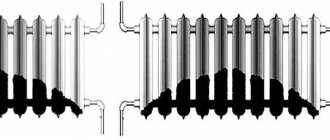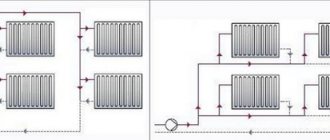Questions and answers about the coolant “Warm House”
Why is coolant needed - antifreeze?
The main task of the “Warm House” coolant is to prevent the destruction of heating and air conditioning systems as a result of defrosting, as well as to protect them from the formation of corrosion and scale, which leads to a sharp deterioration in heat transfer and an increase in energy consumption, and subsequently to failure. In reality, the “Warm Home” TN is used very widely. Naturally, both in individual systems of small buildings and cottages, and in heating networks of multi-storey buildings, entire villages, industrial and commercial facilities, in systems of cold storage plants and storage facilities, for sports facilities (skating rinks and football fields).
In which boilers is the “Warm House” heating element used?
TN “Warm House” is suitable for all types of boilers, except electrolysis ones (type “Galan”). There, the VT must have a certain electrical resistance, for which it is saturated with salts. But this worsens all other parameters for protection against corrosion and scale, so the developers of “Warm House” refused to create a joint universal recipe.
What is the difference between TN “Warm House” and antifreeze?
Most antifreezes contain nitrites, amines, phosphate and silicate compounds, which form fumes harmful to humans and animals. They have a limited service life (2-3 years). In addition, antifreezes are not designed for dilution at all, especially with tap water. TN “Warm House” is approved for use in residential premises, and “Warm House - Eco” can be used in the food industry. They are diluted with ordinary tap water to -20C, as they contain more powerful additives. Service life – at least 5 years.
What is the difference between the “Warm House” HP and other coolants?
The thermal and physical characteristics of all glycol-based coolants, regardless of color, are absolutely the same (if, of course, they are produced without violating the technology). Their main difference lies in the formulation of the additive package, which must withstand dilution with hard water and protect systems from corrosion, scale and foaming for a long time. TN “Warm House” has passed the test of quality and time: most leading companies in the field of heating and heating equipment have chosen in its favor. Antifreeze manufacturer - KhimAvto Group of Companies - one of the largest in Russia. Our own modern plant, stable operation, well-known product brands, low cost, prompt delivery, favorable working conditions for wholesalers - these are the basis for successful promotion in the market.
Is it possible to use an aqueous solution of ethylene glycol (MEG) as a coolant?
This solution, of course, will always be low-freezing. The temperature will depend on the percentage of MEG: at – 30C it needs 45%, and at – 20C – 36%. But without additives, such a solution is several times more corrosive than ordinary water. This is what the coolant, antifreeze, becomes after its additives have exhausted their service life. The manufacturer provides a 5-year warranty on the “Warm House” TN.
Where is it advisable to use TN “Warm House-Eco”?
This antifreeze is prepared on the basis of imported pharmacological propylene glycol, therefore it is harmless to people. It can be used without restrictions in any heating and air conditioning systems, especially in double-circuit boilers, as well as in facilities with increased environmental safety requirements.
Is it possible to mix different coolants?
It is not recommended to mix any antifreeze without first checking for compatibility. If the chemical bases of TN additive packages are different, this can lead to their partial destruction and, as a consequence, to a decrease in anti-corrosion properties. TN “Warm House” is fully compatible with TN “Gulfstream”, the most common in the North-West region, but it is not advisable to mix it with TN “Dixis”, which has a phosphate base.
Is it necessary to dilute the “Warm House-65” coolant?
Necessarily! Since diluting the heating element with water, in addition to saving money for the consumer, allows you to increase heat transfer, reduce the density of the mixture and improve its circulation through the system. The likelihood of carbon deposits on heating elements or in the area of burners and the penetrating ability of antifreeze, which is significantly higher than that of water, are also reduced. It is considered optimal for the Central region to dilute the heating element by - 25-30C, for electric boilers by - 20-25C. Even if the temperature drops below the specified parameters, destruction of the system is excluded, since the HP does not expand. It turns only into a jelly-like mass, which becomes liquid again when the temperature rises.
What water is best to dilute the coolant?
Ideally, it is better to dilute TN with distilled water, which does not contain calcium and magnesium salts, since they crystallize when heated and form scale. For example, scale 3mm thick reduces heat transfer by 25% and the system will require large energy consumption. TN “Warm House” contains a special additive that ensures normal operation when diluted with ordinary tap water (no more than 5 units of hardness). For information: water from a well, if a softening system is not provided, may have a hardness of 15-20 units.
Is it possible to use “Warm House” in systems with galvanized pipes?
Any glycol-based antifreeze coolant, including imported ones, cannot protect galvanized coatings. Possible problems (metallized suspension, and then poorly soluble sediments) depend on the volume of such distribution. However, you should know that even hot water (over 70C) also washes away zinc, albeit much more slowly.
What is best to use to seal connections?
You can use sealants that are resistant to glycol mixtures (for example, Hermesil, LOCTITE and ABRO) or silky linen, but without smearing with oil paint.
Are there any mandatory rules that should be taken into account when designing a system if it will operate on coolant?
Since glycol-based HPs are more viscous, it is necessary to install circulation pumps that are more powerful than when working on water (by 10% in productivity, by 50-60% in pressure). When choosing an expansion tank, it should be taken into account that the coefficient of volumetric expansion of the “Warm House” HP (as well as other coolants) is 15 - 20% greater than with water (water - 4.4 * 10-4, and a mixture of HP and water: by – 20С – 4.9*10-4, at – 30С – 5.3*10-4). As a conclusion: the expansion tank should not be less than 15% of the system volume. The maximum thermal power of the boiler when operating on a HP will be approximately 80% of its nominal value.
Can the coolant cause air in the system?
TN “Warm House” in no way affects the formation of voids filled with oxygen or gas formations. The reasons should be sought in errors in the design or installation of equipment: a small expansion tank, the galvanic effect of incompatible elements, incorrectly selected installation locations for air vents, incorrect settings of thermostats, etc.
What does overheating of the “Warm House” HP lead to and how to avoid it?
With prolonged overheating, thermal decomposition of additives and the glycol itself begins. TN becomes dark brown, an unpleasant odor appears, and precipitation forms. Often carbon deposits form on heating elements, which causes them to fail. In order to prevent carbon deposits, it is necessary: – when diluting TN, there is no need to “chase” the freezing temperature, optimally prepared solutions should be at – 20 – – 25ºС; maximum – 30ºС; – install a more powerful circulation pump; – limit the temperature of the heat pump at the boiler outlet to 90ºС, and for wall-mounted ones – 70ºС; – in the cold season, heat the HP gradually, without turning on the boiler at full power.
ABOUT THE USE OF NON-FREEZING LIQUIDS (ANTIFREEZE) IN BAXI BOILERS.
ABOUT THE USE OF NON-FREEZING LIQUIDS (ANTIFREEZE) IN BAXI BOILERS.
IS IT POSSIBLE OR NOT TO PUT ANTI-FREEZER INTO BAXI BOILERS?
THE IDEAL COOL CARRIER IS WATER. This means CLEAR WATER, and not water “from a puddle”, or from a well with an unknown composition, not rain, etc. Water that, when heated, will not form a hard deposit on the heat exchanger and other elements of the boiler, that will not enter into various chemical reactions, etc.
WATER HAS THE ONLY MINUS - AT LOW TEMPERATURES IT FREEZES(((
ACCORDINGLY, ANTI-FREEZE LIQUID HAS THE ONLY PLUS - ANTI-FREEZE LIQUID DOES NOT FREEZE!
We attribute everything else to ITS MINUSES.
PROPERTIES (MINUSES) OF ANTI-FREEZES (NON-FREEZING LIQUIDS):
-Viscosity. That is, the circulation is worse than if there was water in the heating system. The consequence is the likelihood of deposits, overheating of the heat exchanger, micro-boiling of the main heat exchanger of the boiler. Overheating is also associated with the appearance of noise, whistling, and knocking during operation of the boiler heat exchanger.
Sometimes it is necessary to install a more powerful heating system pump.
-Fluidity. Gaskets, rubber bands, connections will leak... Both in the boiler and in the heating system.
– Tendency to various chemical reactions inside the boiler and heating system. With aluminum, with iron, copper (the heat exchanger and tubes in the wall-mounted traditional BAXI boiler are copper) This is also due to the fact that the liquid can contain various additives, and can also be diluted with water of unknown composition.
An extreme option that periodically occurs is a fistula of copper tubes and the main copper heat exchanger. This is when small holes form in the copper, as if pierced with a needle. This process can be called copper electrolysis and occurs in the presence of electrical potential, which can come from anywhere. For example, it appears when the water heater adjacent to the boiler is turned on, etc.
ALL THE PEOPLE WHO CONTACTED US WITH THIS PROBLEM HAD NO FREEZE IN THE HEATING SYSTEM!
WE HAVE NEVER ENCOUNTERED DAMAGE TO PIPES AND HEAT EXCHANGER WHERE THERE IS WATER IN THE SYSTEM!
Of course, the problem does not occur in Baksi boilers, but in all boilers of any manufacturer that have copper parts (almost all household traditional wall-mounted boilers)
-The need to comply with the recommended concentration.
-The need to replenish the system either with the same liquid or with CLEAN WATER.
It is IMPOSSIBLE to dilute the liquid with “puddle water” and “well water”. It is also impossible to mix liquids of different types and manufacturers.
-Limited service life. For different manufacturers, from 1 year to 5 years at best.
In a year, it may already be dirty slurry, it may curl into flakes, release sediment that will clog the heat exchanger...
ABOUT THE TYPES OF NON-FREEZING LIQUID.
The Baksi company ALLOWS the use of two types of liquids in its boilers
In single-circuit boilers, antifreeze is based on ethylene glycol.
In double-circuit boilers, antifreeze is based on propylene glycol.
ETHYLENE GLYCOL is toxic, has a shorter service life (1-3 years), is more active and aggressive. Plus ethylene glycol - the price is lower, it comes in a concentration of -65, to obtain the recommended concentration it can be diluted with water...
PROPYLENE GLYCOL is food grade, non-toxic, has a longer service life (up to 5 years), is less aggressive, and causes less harm to the boiler. Disadvantages - the price is about 2 times higher than ethylene glycol, it often comes in a ready-made concentration, that is, it can no longer be diluted.
DO NOT use GLYCERIN-based liquids due to increased viscosity. When using such fluids, customers have encountered problems such as heat exchanger noise, etc.
Antifreeze and automobile antifreezes also CANNOT be used in heating systems.
Also, we do not consider alcohol as a coolant.
ADDENDUM FROM BAXI:
IMPORTANT NOTICE. Related to the design of boiler heat exchangers.
It is PROHIBITED to pour non-freezing liquid as a coolant into BAXI CONDENSING boilers, as well as into boilers of the Main, Main Four, Main 5 series. THAT IS, ANYTHING IS PROHIBITED.
It IS ALLOWED to pour other types of liquid into boilers, but the Baksi company, as well as service representatives, are not responsible for the consequences caused by the use of non-freezing liquids.
ABOUT ANTI-FREEZE MANUFACTURERS.
The Baksi company does not produce antifreeze liquids itself and does not recommend specific manufacturers.
The main thing is that the antifreeze is intended for HEATING SYSTEMS.
Our company, if necessary, uses antifreeze from different manufacturers, the main criterion is availability in the supplier’s warehouse and the ability to deliver quickly.
BUT! Due to the large number of FAKES, as well as the impossibility of quality control, we do not recommend liquids from specific manufacturers and do not sell anti-freeze liquids in our store!
We cannot conduct an examination of each canister of liquid, we cannot know where it actually came from from a trusted supplier, we do not know what is actually filled inside the canister, even if a quality certificate is attached to each batch. Therefore, even if, at your request, we purchased and poured liquid into your heating system, we are not responsible for its quality, as well as for possible damage caused to the boiler and system.
That's why. WHAT SHOULD YOU DO?
IF THERE IS NO CHOICE. If your house is located in the region, IF YOU DO NOT LIVE IN THE HOUSE, or you don’t live yet, because there is construction going on, repair work, then DEFINITELY FILL IN AN ANTI-FREEZE LIQUID.
Where there is a construction site, there is only antifreeze. Because there is a high risk of defrosting the boiler and system.
If where you live there are frequent, permanent power cuts in the winter. Let me remind you that Baksi boilers are energy dependent; without electricity, the boiler will not work. At minus 30 in the winter, the boiler itself, if it is not working, that is, there is a fault or there is no electricity, can defrost in just a few hours through a coaxial chimney that goes outside, while the boiler room will still be warm.
The damage from a defrosted heating system or a defrosted boiler is many times higher than problems with the boiler that are caused by the use of antifreeze.
If this is a city house, you live in it with your family, someone is always at home, you can fill the water. If the electricity goes out or if the boiler breaks down, people will take measures to prevent the boiler and the system from defrosting.
By the way, liquid pleasure is not cheap.
SINCE WE ARE A SERVICE SERVICE FOR BAXI BOILERS, THE ISSUE OF USING ANTI-FREEZE IS CONSIDERED BY US EXCLUSIVELY FROM THE POSITION OF THE WELFARE OF THE BAXI BOILER.
-Where possible, we fill in the ideal coolant - CLEAN WATER.
WHEN POSSIBLE, THE USE OF ANTI-FREEZE SHOULD BE REFUSED.
HOWEVER, IN THE EVENT OF DEFROSTING OF THE BOILER OR SYSTEM, ONLY YOU AS THE OWNER BE RESPONSIBLE!
-Where there is a danger of defrosting, fill in anti-freeze at your own risk. The Baksi company and service representatives are not responsible for breakdowns and problems associated with the use of antifreeze.
-If possible, use propylene glycol based fluids. This is the lesser evil.
-Dilute antifreeze with PURE WATER ONLY. For example, distilled.
-For manufacturers, choose for yourself, there are no specific recommendations, and there cannot be, due to the large number of fakes and the impossibility of quality control from batch to batch.
WE ARE NOT RESPONSIBLE FOR THE DECISION YOU MAKE!
ONLY YOU DECIDE TO FILL ANTIFREEZE OR WATER!
YOU AND ONLY YOU, AS THE OWNER OF THE BOILER AND SYSTEM, ARE FULLY RESPONSIBLE FOR YOUR DECISIONS AND FOR YOUR PROPERTY!
How to properly dilute antifreeze for a heating system?
When pouring Dixis-65 concentrate, or another composition in the form of a concentrate, mix it with water only in a separate container. And only after that, fill the system with the already prepared, uniform mixture. Mixing antifreeze with water inside the system can unexpectedly make it difficult for the system to function properly. The result of improper mixing: – uneven heating of heating devices, and some devices do not heat at all due to the separation of water and antifreeze; – malfunctions of the circulation pump and even its failure; – foaming inside the system leads to its forced complete emptying, repeated flushing and refilling; – UNDER NO EVENT DO YOU STIR THE DIXIS-30, and especially DIXIS TOP, that is ALREADY READY for pouring. In this case, the foam will clog the system so much that it will be difficult to even rinse it again. When using expensive equipment, such things are generally unacceptable! If it’s already late and you poured liquid first and then water, DO NOT TURN THE CIRCULATION PUMP ON AT MAXIMUM speed (so that it mixes faster). Let everything remain as it is. Be patient. Periodically open the air vents on radiators. It takes time for everything to come together. In the case of gravitational systems (gravity flow), things are more complicated, and mixing takes much more time. That is why in almost all gravity systems we install a circulation pump through the bypass. Be patient and wait until it mixes. Dixis-65 concentrate is much cheaper in diluted form than Dixis-30 and even more so DIXIS TOP. But in practice, if your specialist has little experience, use only ready-made solutions offered by the manufacturer or contact us.
Antifreeze "DIXIS-65" is widely used in various systems - cooling, heating and air conditioning - not only in industrial but also in residential premises. The priority purpose of this antifreeze is to protect the system from so-called “defrosting” in low temperature conditions. In addition, DIXIS-65 antifreeze copes very well with the function of protecting equipment from corrosion processes and the onset of scale formation. A distinctive feature of DIXIS-65 antifreeze is the ability to use it both in its original and in a diluted state. In its original form, this coolant can be used in low-temperature climatic regions, for example, regions of the Far North. In a diluted state, DIXIS-65 can be used in regions with a temperate climate, where temperatures are not so low. By diluting this antifreeze with water in a ratio of 5:1, we obtain a coolant with a crystallization onset temperature of minus 40°C. Ratios of 2:1 and 1:1 make it possible to obtain antifreeze with an onset of crystallization equal to minus 30°C and minus 20°C, respectively. Antifreeze "DIXIS-65" is a homogeneous transparent liquid with a yellow-greenish color without mechanical impurities.
Reviews
We use “Warm House” -65 for our heating. It is often counterfeited, but if you buy it from a trusted store, you can hope that it will serve well. Convinced by my own experience.
I pour this coolant into the heating myself. But my heating system is low temperature. The temperature is no more than 60 degrees (if it’s 20 outside). It works fine, for heating with temperatures up to 80 degrees, the additives will probably decompose. You must carefully read the certificates to determine the highest operating temperature it can be used. Please also note that heating elements are designed to work with water.
I purchased the “Warm House” composition - as soon as I filled the system with the pump, I immediately noticed that the gaskets were leaking. If you use water instead of coolant, then after it you need to tighten all the connections; it is a very fluid liquid. There are no complaints during operation; in winter, this mixture heated the house normally. When we left it for almost three weeks, it did not freeze.
How and with what to dilute the coolant for the heating system?
Many manufacturers sell concentrated glycol-based coolants. They categorically cannot be poured into the system in their pure form, otherwise you will encounter serious problems, the solution of which will take time and additional funds. Negligent attitude towards expensive equipment leads to almost irreparable consequences. For this reason, we do not recommend doing it on your own. It is better to first consult with the manufacturer and strictly follow the existing instructions. Today we will answer the question “how to dilute the coolant for the heating system https://www.eglikol.ru/hot-stream-teplonositel-dlya-sistem-otopleniya” and give advice on how to do it correctly.
Preparing coolant for filling from concentrate
Household antifreeze must be diluted with distilled water, and always before pouring it into the system, in a specially prepared container. Regular tap water contains many unnecessary impurities that will impair the performance of energy systems. Distilled water is completely purified and helps extend the service life of the coolant.
If you decide to mix concentrate with water in the system itself, you will encounter the following problems:
• uneven heating of the equipment; in some parts it may not produce heat at all, since antifreeze and water are located in different places; • failures in the functioning of the circulation pump, and sometimes it stops altogether; • foaming, to get rid of it, you will need to remove antifreeze from the system and refill it.
To prevent this from happening, dilute the antifreeze in advance and fill in the already diluted one.
The coolant, ready for use in equipment, does not need to be diluted. This will change its properties. As a result, it will not be able to function properly and fulfill its intended purpose.
Before adding new antifreeze, be sure to pre-flush the system and boiler. Only after this can the coolant be changed.
What do you need to know before choosing a coolant?
• The decision about which coolant to use is made at the equipment design stage. Antifreeze and water require different supply systems.
• Pay attention to the various characteristics of the substance: its composition, additional additives, safety, shelf life and others. It is important to compare this with your terms of use.
• Carefully read the instructions for use, otherwise you may encounter serious problems (incorrect filling, harm to human health, damage to equipment).
The concentration of water in antifreeze determines what temperature conditions it will withstand, so before diluting the coolant, consult with the manufacturer.
Water requirements and recommended proportions
Concentrated ethylene glycol can only be diluted with demineralized or softened water (hardness should not exceed 5 mg per equivalent). This is done to ensure that dissolved salts do not lead to the formation of sediment that clogs the climate system and impairs the heat exchange of equipment.
Manufacturers do not recommend pouring coolant with a glycol concentration of more than 70%, because it has increased viscosity and creates additional load on pumping equipment. Concentrated glycol also has reduced thermal conductivity, which negatively affects the efficiency of the climate system.
In addition, to obtain a workable solution, it is necessary to take into account the climatic conditions in which the equipment will be used. If we are talking about a purchased glycol solution with a volume fraction above 40%, then the freezing point of such antifreeze will be 65 degrees below zero.
In temperate latitudes this is practically impossible, therefore, in order to save money, you can dilute the solution with water, increasing the freezing temperature to the following values:
- Dilution in a ratio of 1 to 1 allows you to achieve a freezing temperature of – 35-40 degrees;
- Dilution in the proportion of two liters of concentrated glycol to three liters of water -30 degrees below zero;
- Proportion 1 to 2 – 20 degrees below zero.











